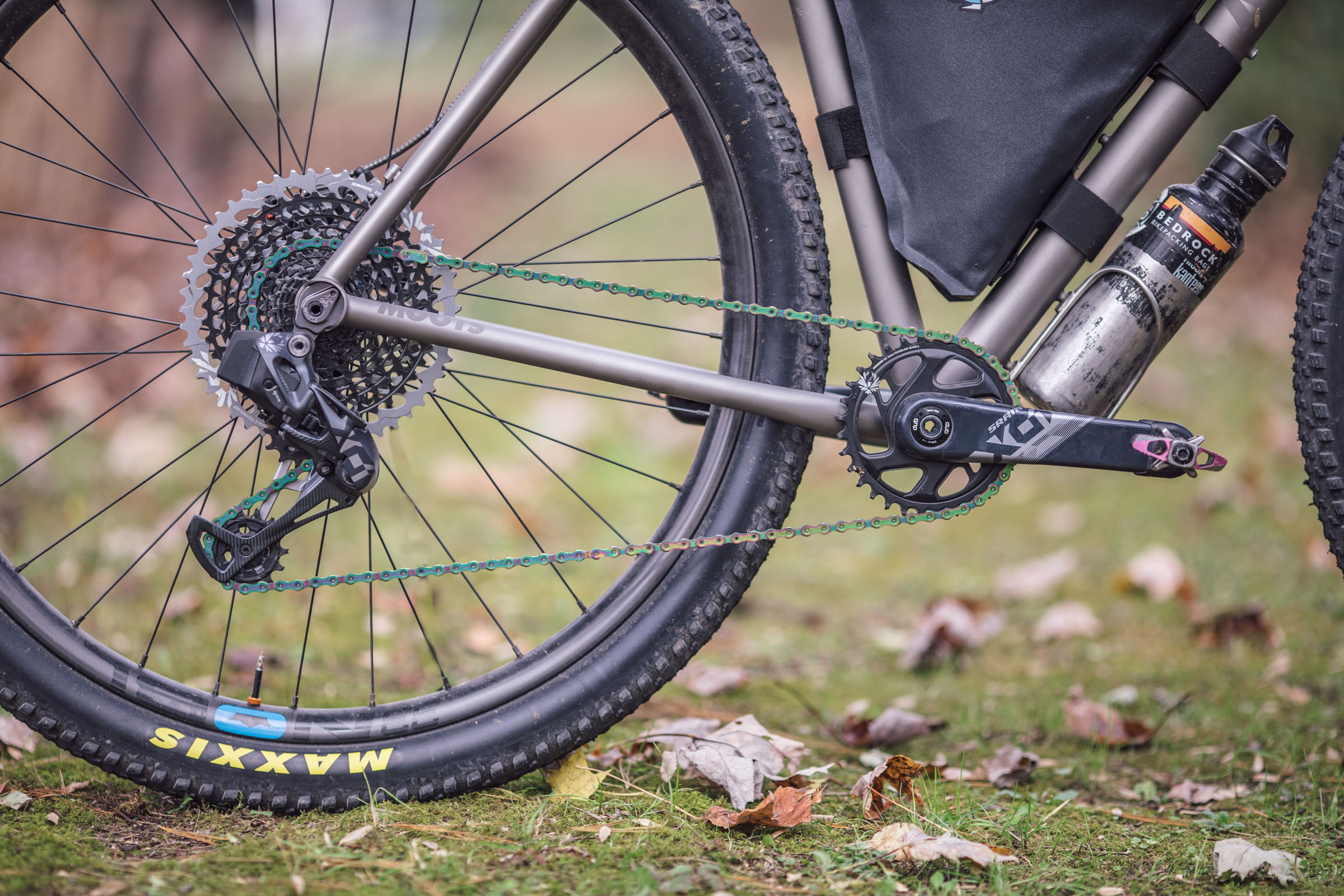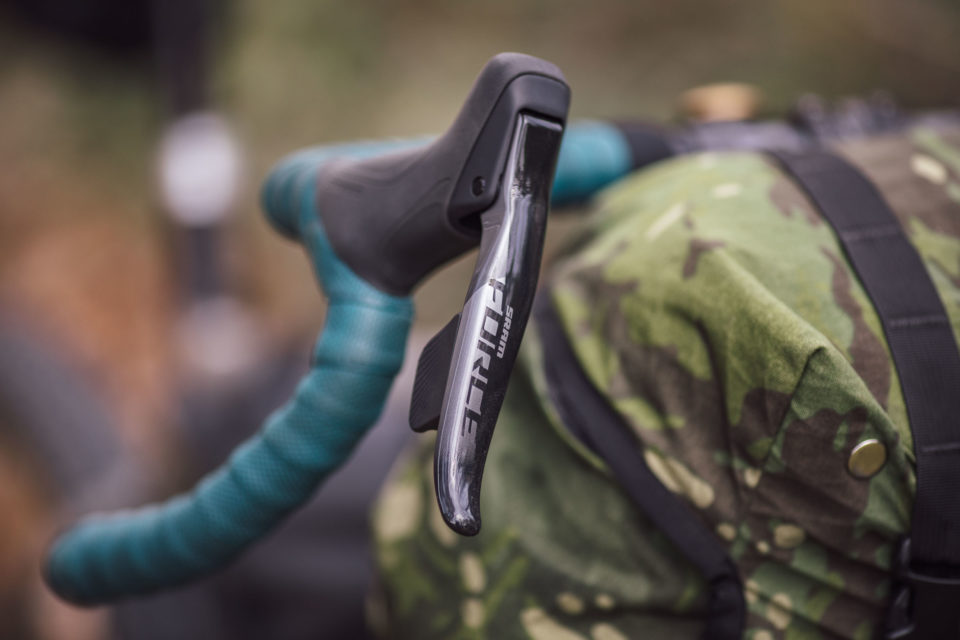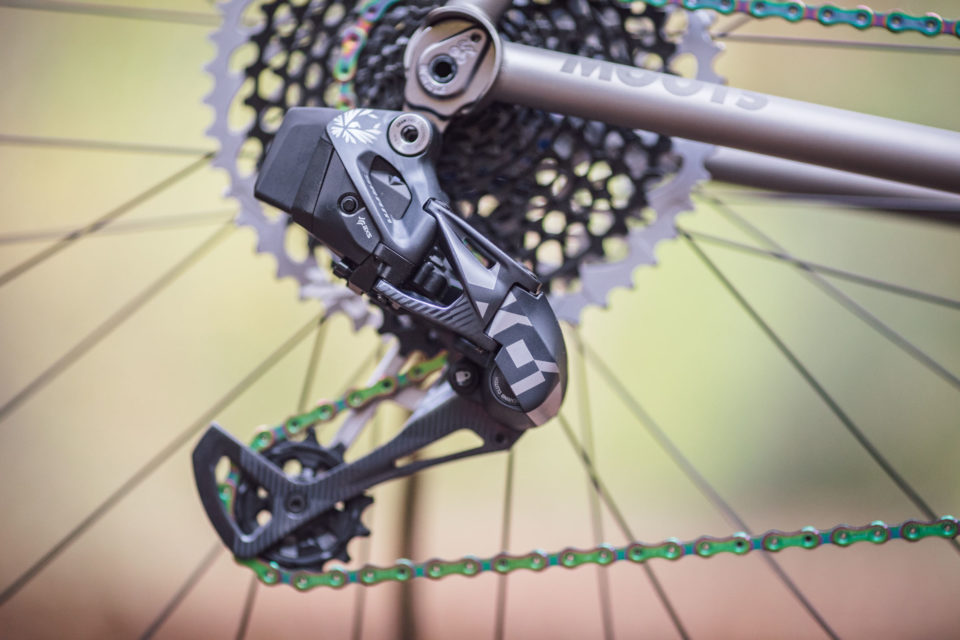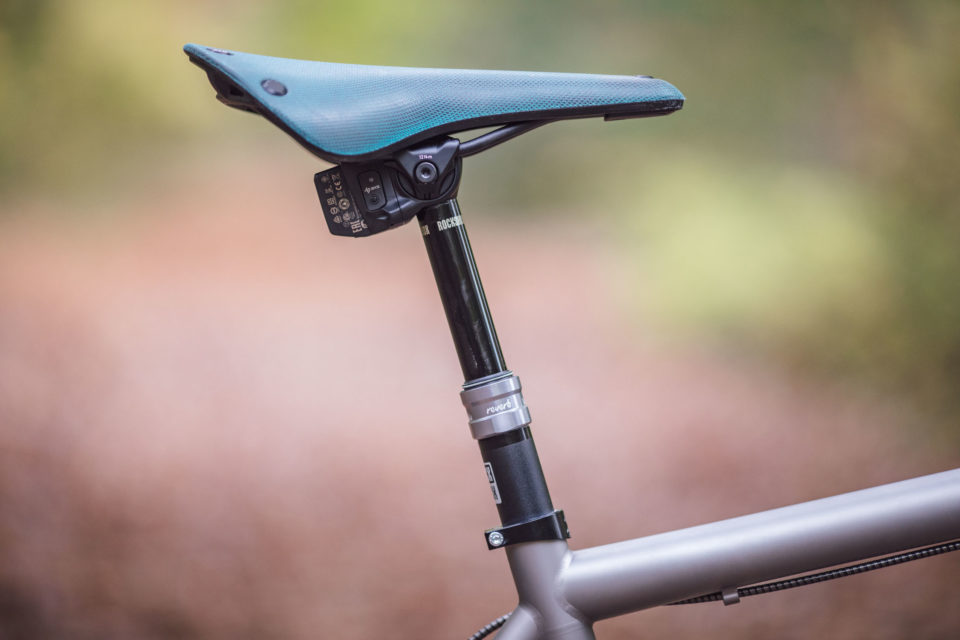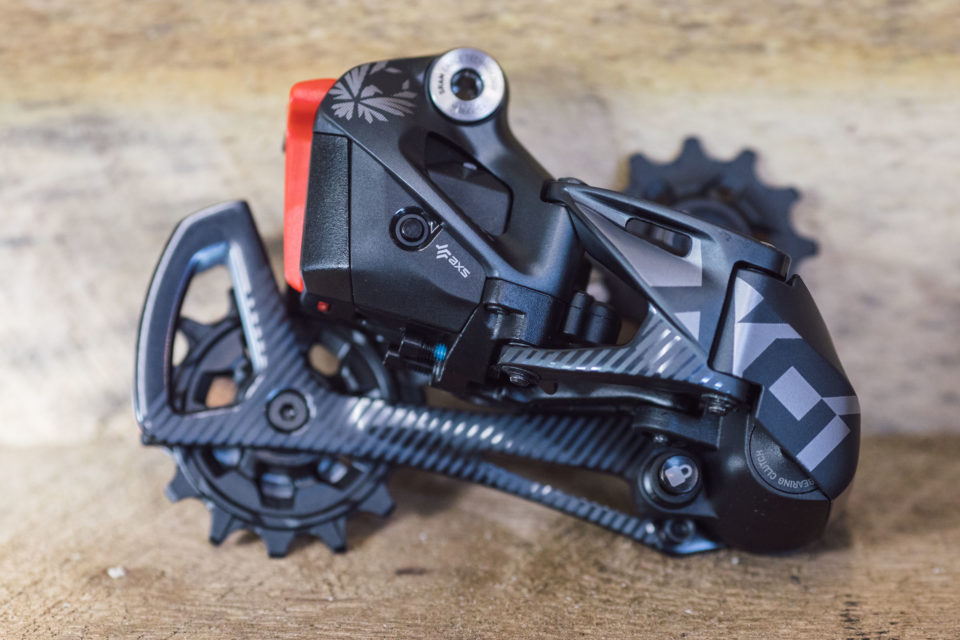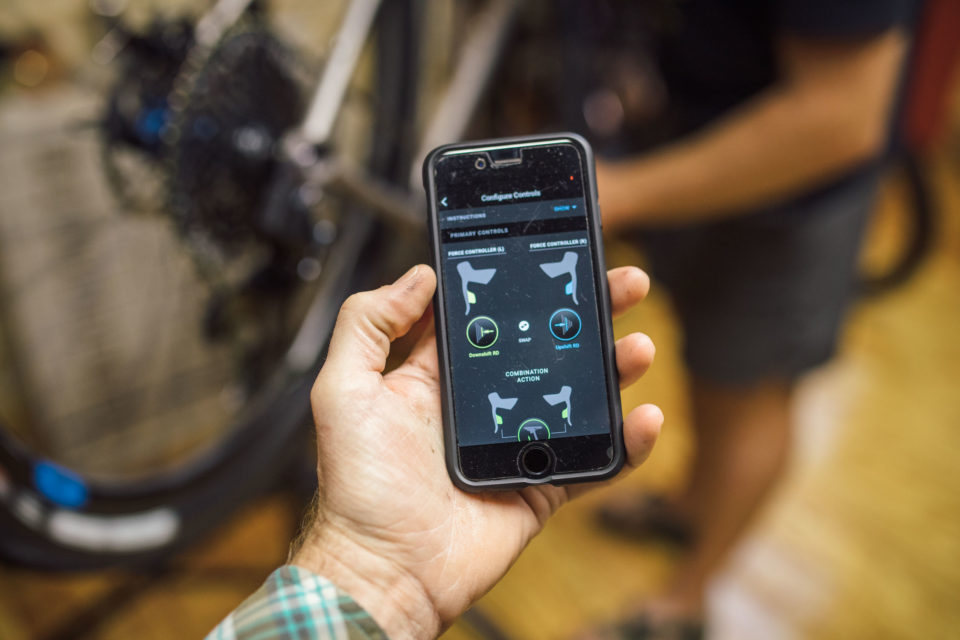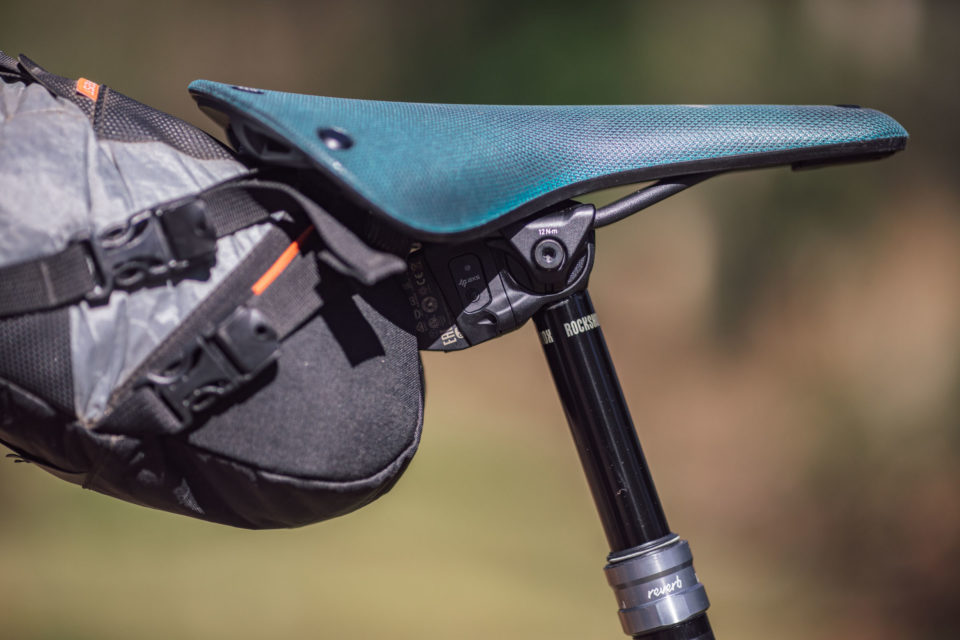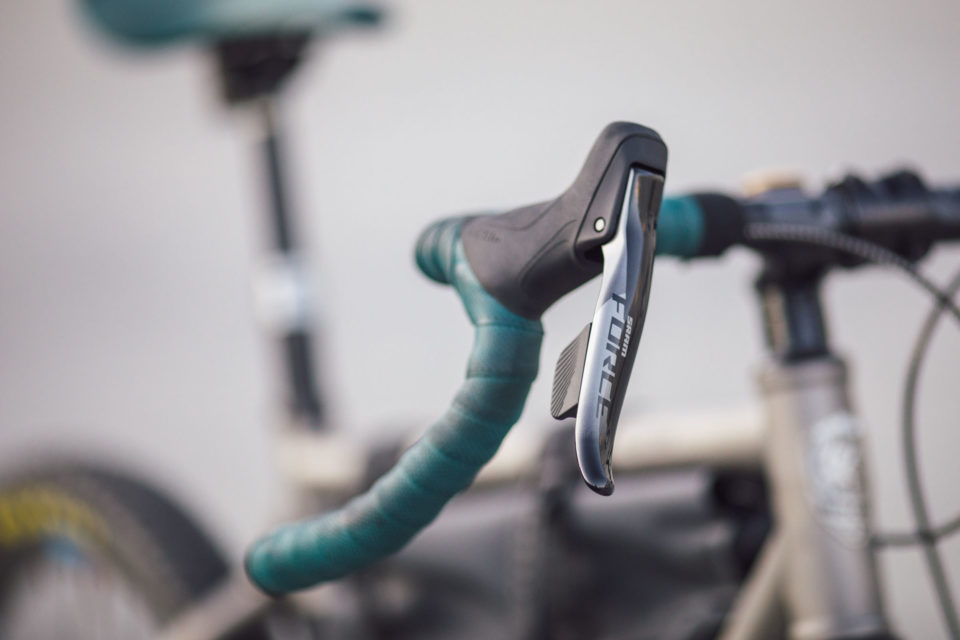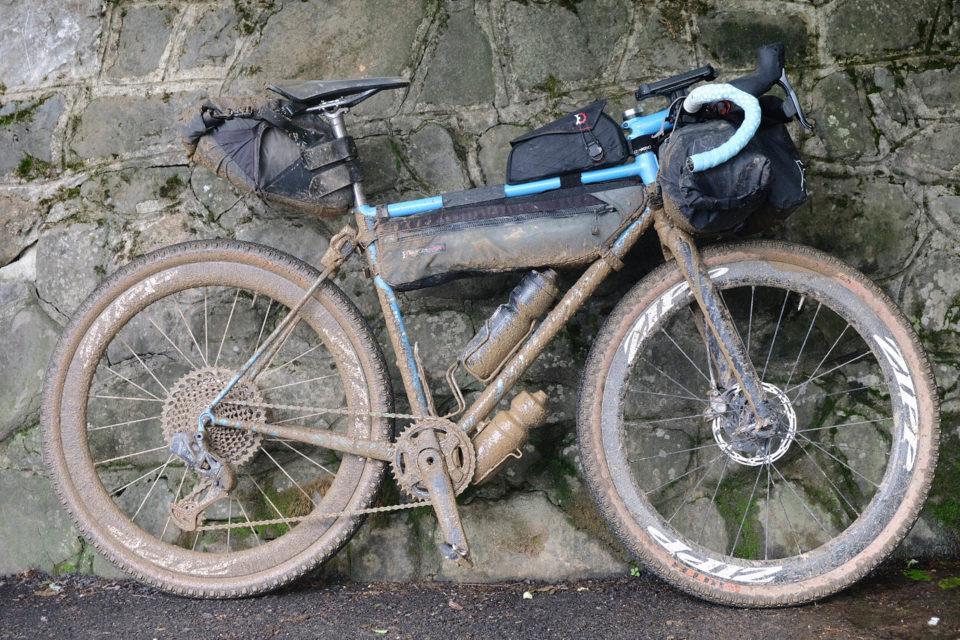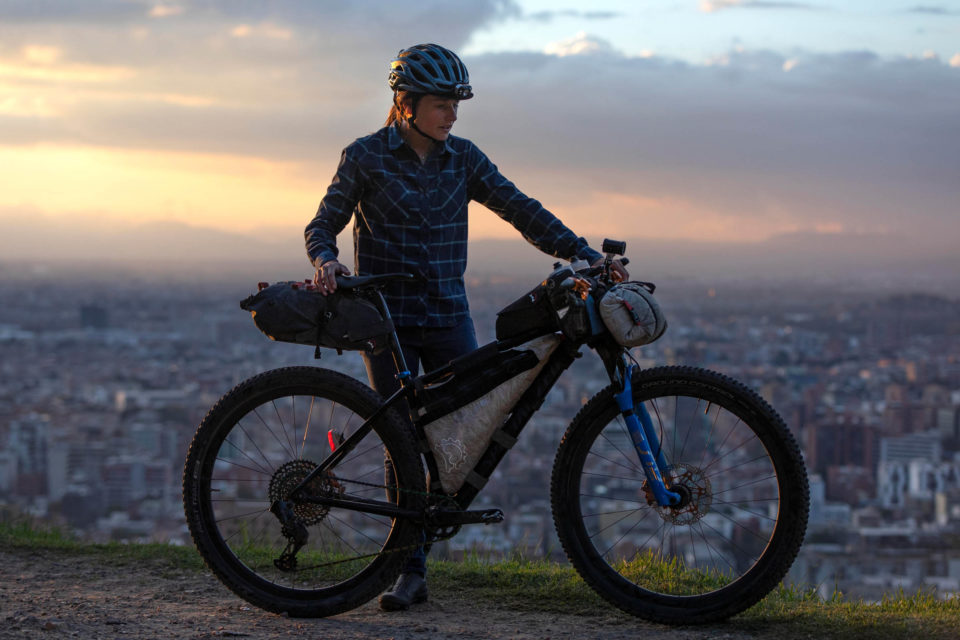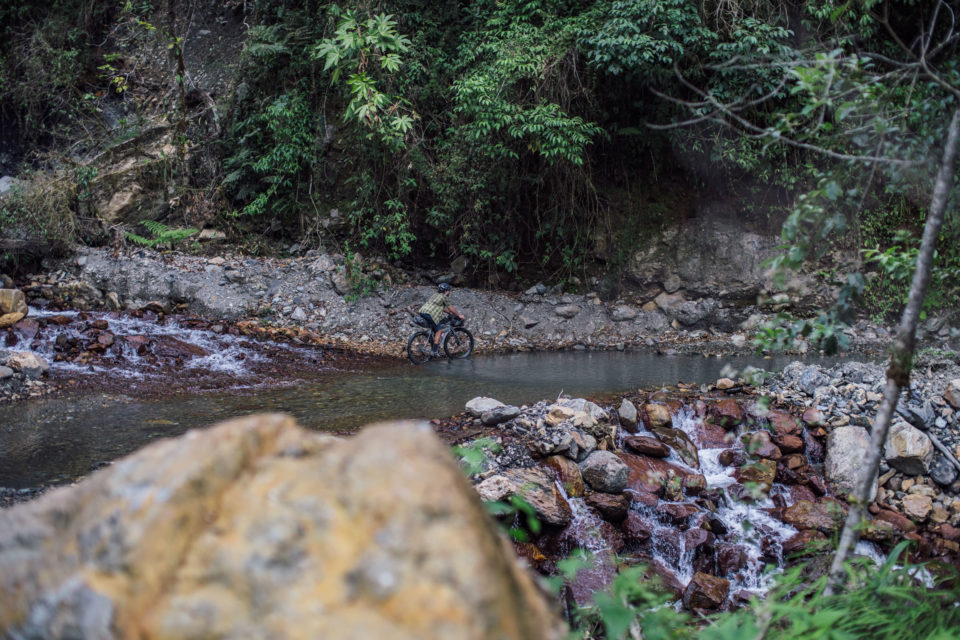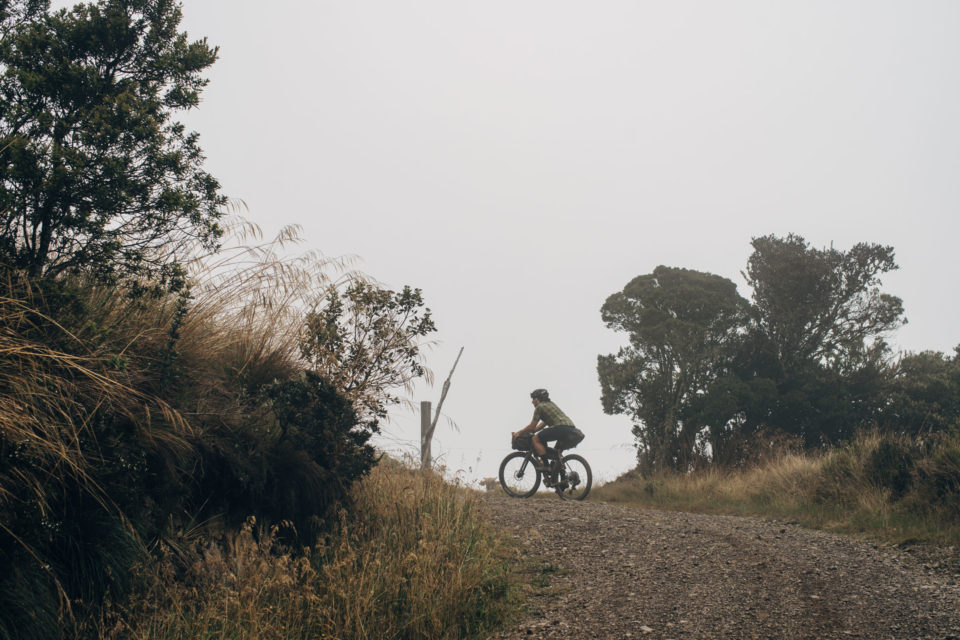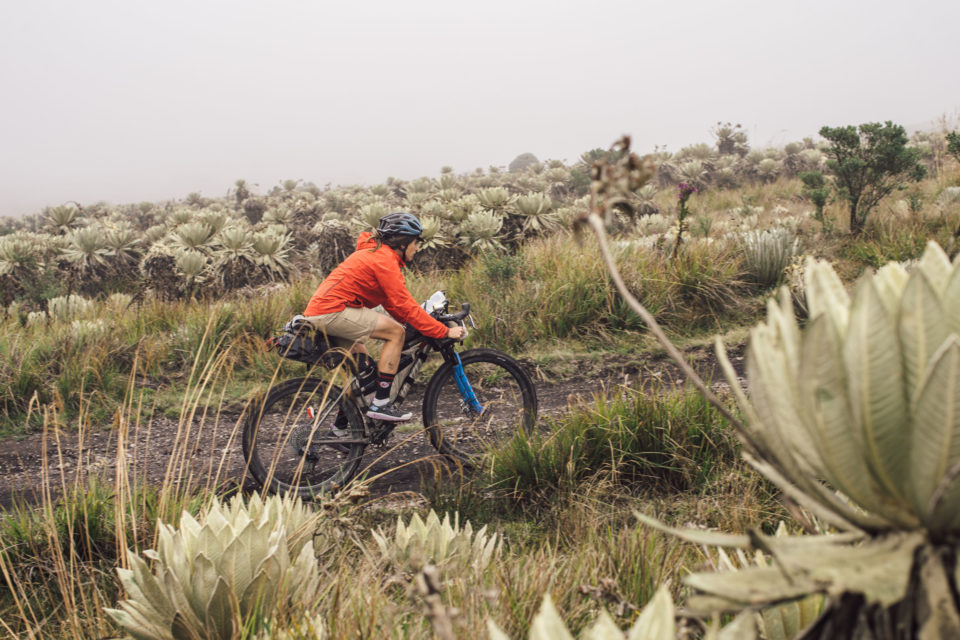SRAM AXS Review: Is AXS ready for big adventures?
Share This
There are plenty of SRAM AXS reviews already out there, but how about ultra-long term testing? We’ve put in over eight months on ours. Moreover, we asked three bikepackers who’ve ridden with AXS drivetrains over thousands of miles for their feedback and whether they’ve had any issues in the backcountry. Plus, everything you need to know about the SRAM AXS “Mullet” — one of only a few ways to get an ultra-wide range 1x drivetrain on a drop-bar bike…
It’s easy to scoff at the prospect of long-distance bikepackers whizzing around with electronic, wireless drivetrains. After all, most of us are natural born luddites who are hellbent on reliability. We all have some quixotic vision that our bikes should be built to survive a 20,000-mile journey to the edge of the Earth and back. But in reality, 99.9% of us don’t need an apocalypse-proof rig with a weldable swingset-steel frame, legacy QR hubs, and a replace-anywhere square-taper bottom bracket. I once thought I did, but curiosity smelted most of the chromoly from my O.L.D. soul as I was lured to the dark side by dropper posts, new hub standards, carbon handlebars, and now, a robotic drivetrain. And if you listen closely enough, you might just hear the me from several years ago laughing at the current me.
All that said, I must admit that SRAM AXS brought a familiar aphorism to mind, as have several other modern bike components: don’t knock it until you’ve tried it. And, I wasn’t alone. Among others, long-distance bikepackers such as Lael Wilcox, Neil Beltchenko, and Joe Cruz—who’s luddite enough to have never tried a dropper post—took the flashy bait. Who would’ve thunk! In this review I’ll spell out all the details on the AXS “mullet” configuration, offer my impressions on the system, and ask those three about their experience on big rides such as the Tour Divide, backcountry singletrack in Washington state, and crossing Colombia’s remote Paramos.
Before I get too far into any of it, let’s talk about AXS’s price, which is a little bit of a slap in the face—the Eagle AXS MTB group goes for $1,900 for everything (shifter, derailleur, cassette, chain, crankset, charger, etc). What about AXS would convince people to spend that kind of money when they can get a perfectly good Eagle GX drivetrain with the same gear range for 1/5 that? Yes, AXS has the wow factor to woo over the gravel-is-the-new-golf crowd. But the price tag of the entire group makes it a non-starter for most of us. When you break it down and look at just the necessary parts, it becomes a little more palatable. You can buy the cheaper Eagle GX cassette, chain, and crankset, so all you’d really need to think about is the price for the derailleur and shifter.
Here’s how that compares, for both the MTB setup as well as the mullet configuration (if you don’t know what a mullet is, we’ll get to that later). Note that “AXS-X01” stands for AXS Eagle X01 components; “AXS-M” represents the mullet build with Force AXS shifters (mechanical brake levers) and the Eagle X01 derailleur; “RIVAL” represents Rival 1 with mechanical brakes (for a drop-bar comparison); and the other two are standard mechanical SRAM Eagle groups. Following the pricing table is a weight comparison, in case you were curious.
| Group | AXS-X01 | AXS-M | X01 | GX | RIVAL |
|---|---|---|---|---|---|
| Shifter | $200 | $710* | $130 | $45 | $120** |
| Derailleur | $700 | $700 | $225 | $125 | $115 |
| Total | $900 | $1450 | $355 | $170 | $235 |
*Force AXS eTap lever (pair) **Rival 1 eTap lever (pair)
Weights: SRAM AXS Eagle vs. Eagle GX/X01 and Rival 1
| Group | AXS-X01 | AXS-M | X01 | GX | RIVAL |
|---|---|---|---|---|---|
| Shifter | 82g | 303g | 122g | 124g | 332g |
| Derailleur | 391g | 391g | 288g | 276g | 280g |
| Total | 473g | 694g | 410g | 404g | 612g |
Ultimately, the AXS shifter/derailleur pair weighs a little more than it’s mechanical competition. However, this doesn’t account for the cables and housing. Taking that into account, the AXS system likely weighs a hair less.
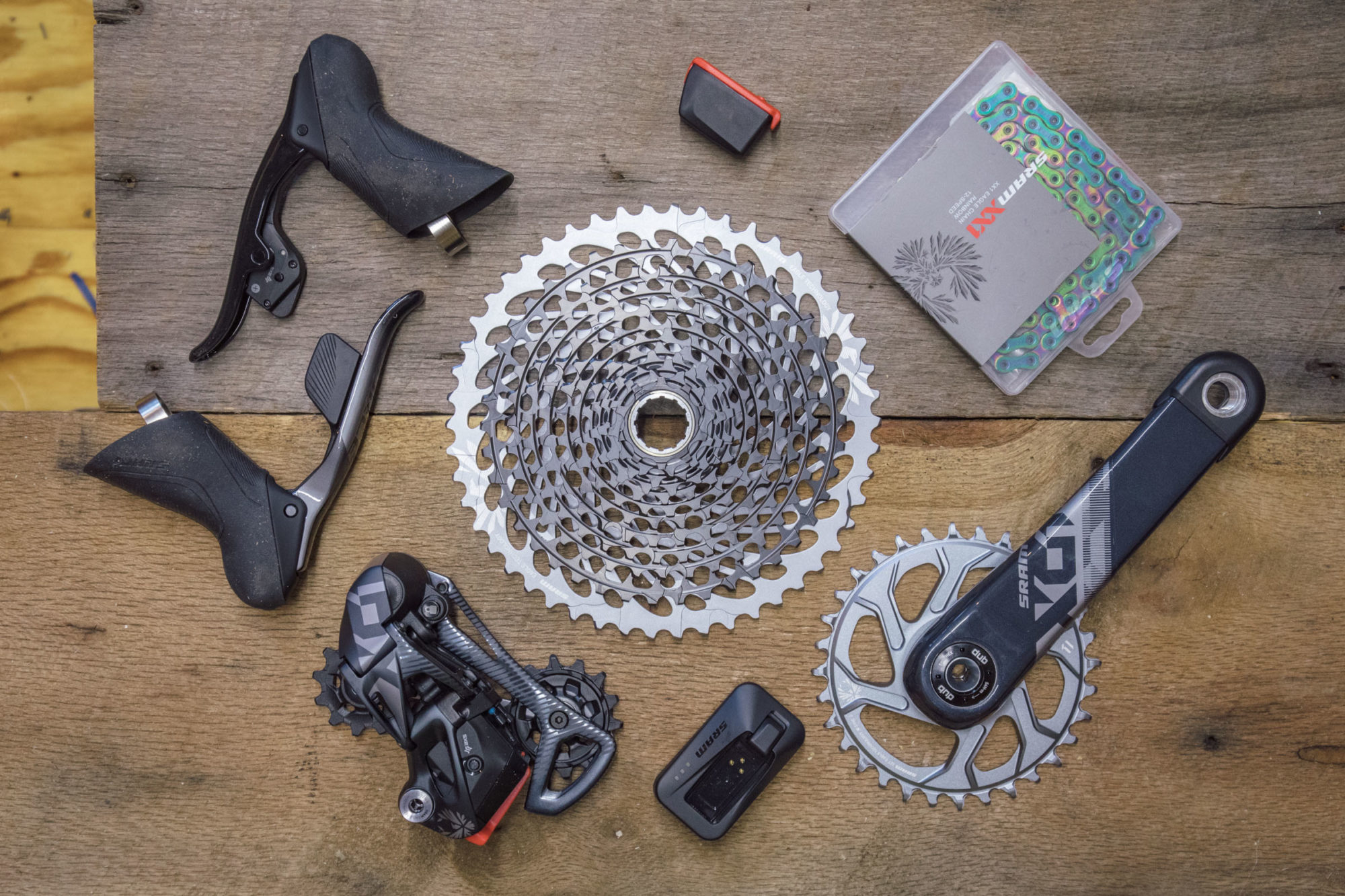
Call me on my drivetrain
As illustrated above, AXS is still comparably quite expensive even with the bare minimum components. And if that doesn’t make it a no-go for you, the electro-bleep-bloop tech might. So, why does it even exist? Some may plead that it’s all about innovation for the sake of industry. But if you’re my age and riding anything other than a 3×9-equipped 26er, you’ve embraced modernization to some extent. It was only a matter of time until someone attempted to cut the cables, and SRAM clearly worked on it a long while before its release last year.
With that in mind, let’s first consider the level of innovation and technology that went into this thing, as that in itself is pretty damned impressive. Stating the obvious, for one, AXS is the first drivetrain on the market that’s fully wireless. When I first heard that, I imagined mid-ride alerts buzzing my phone and throwing me off my line; searching for network, fatal error, and please call your wireless service provider sprung to mind. However, that certainly hasn’t been the case. In my experience, AXS is incredibly polished, to the degree that I would even say that its price is justified. I can’t imagine the amount of R and D that went into the wireless aspect alone. In short, AXS components connect to one another using SRAM’s own proprietary encrypted wireless network that they created from scratch. It’s not Bluetooth, but something like it. I haven’t had any delayed signals, disconnects, or other issues that one might fear come hand in hand with the word wireless. It just works, crisp and immediate.
Better yet, this wireless network allows both the AXS road group (Force AXS) and MTB groups (XX1 or X01) to talk with each other. That means you can make a mullet without any hacks: road shifters (business in the front) with an Eagle AXS derailleur and cassette (party in the back)… and toss on an AXS Reverb dropper post for extra party.
Obviously, there are zero wires (except brakes, of course), which means no shifter cable(s), and if you use the dropper post, no cable for that either. It didn’t dawn on me just how cool that was until I actually installed it. Not only does this make it easier to set up, it eliminates two cables from the cockpit—that’s two fewer cables to worry about getting damaged, or getting in the way of your handlebar bag. Without going into a full nitty gritty review on every last component (there’s been plenty of those already, and this is more of a long-term look), let’s reflect on some of the unexpected highlights within the system.
SRAM AXS Eagle Derailleur
The derailleur is the most technologically dazzling component in the group. At its heart is a small electric motor that runs at 80,000 RPM (over 10 times that of a typical automobile engine—large jet engines operate around 10,000-25,000 RPM, for example). When triggered by the shifter, the motor engages and turns a tiny gearbox that translates those RPM into torque, which moves the derailleur cage inward and outward to shift the chain through the cassette. It emits a zzzzt sound on each shift and feels very precise.
Another cool feature within the derailleur is the internal “Overload Clutch.” This allows the derailleur to protect itself by moving inward when the it takes a hit or experiences an impact; it then seamlessly resets into place, potentially saving a derailleur hanger. The primary purpose of the Overload Clutch is to protect the shift motor, but a welcome byproduct is that it protects the derailleur and hanger from damage. Have a look at a video of this in action here.
Setting up the derailleur is fairly straightforward. Like a standard mechanical derailleur, it has limit screws and a B-tension screw. SRAM sends a unique purple chain gap guide with the derailleur to align the B-gap. Adjusting the pulley alignment is performed by holding down the small round button (on the inside of the paddle on eTap levers, and under the paddle on MTB lever) and clicking the paddle. It’s all fairly intuitive. You can find the installation videos here: Road / MTB.

AXS App
To set up the system, you must first pair the shifter and derailleur, which is also pretty simple using the round buttons on each component. Once they’re paired, you can use the AXS phone app to custom configure the controls. There are several options, but the most obvious is changing what the right and left levers do (on the eTap drop levers, each has a shifter paddle). I set it up so the right lever upshifts (to harder gears), and the left downshifts, and when both are pressed simultaneously, the dropper post is triggered. The app is also handy for updating firmware on the components, and monitoring battery life—including the CR2032 batteries in the eTap shift levers. There are also a couple of interesting deepcut shift settings you can mess with in the enhanced mode screen, like:
- Sequential mode: for 2×12 systems, you can set it to sequential mode where it will automatically shift the front derailleur for you; this operates as is it was a 14-speed 1x system
- Multishift: when you hold down the shifter it will multishift through all the cogs; you can change this to limit that to either two or three
There are a few other tech tricks that don’t necessarily involve the app, but kind of fit in this section of the article. One is AXS’ ability to connect with GPS head units, such as the Wahoo ROAM. Apparently, it can be set up to display what gear you’re in, as well as track how many shifts you make on a ride. I haven’t tried either of these, but I could see some interesting potential.
AXS Shifter (MTB and Force AXS eTap)
There are two shifter options with an AXS drivetrain. The mountain bike shifter is the least expensive and has a simple rocker thumb paddle that’s super easy to operate. Unlike a mechanical shifter, your thumb doesn’t pull the cable; it simply activates the derailleur motor, so there’s no muscle work involved. I haven’t really used this other than playing with it, instead opting for the Force AXS levers and Eagle X01 build on the MOOTS Baxter I’m testing.
The Force AXS levers are much more expensive than the MTB shifter, and you have to have two of them to operate the system—one of the eTap paddle downshifts, the other upshifts. Fortunately, you can get them for either hydraulic or mechanical brakes. I opted for mechanical and used the Ultimo brakes on this bike.
As mentioned above, the shifters also offer electronic functionality that allows you to tweak the pulley alignment, which replicates cable tension adjustment. This is done via the small pairing button on the underside of the MTB shifter (on the inside of the paddle on the Force lever). So, if your derailleur goes out of whack from a crash, you can use this feature to realign where the derailleur pulley stops, similar to a barrel adjuster on a standard mech.
Rockshox Reverb AXS
Not to be left out, the AXS iteration of the Reverb dropper post has all the obvious benefits of AXS—no wires or cables—with a few other features that attempt to justify its hard-to-swallow $800 price tag. Let’s be honest, that’s really expensive; basically triple that of other reliable posts currently on the market. One hidden perk with the wireless aspect is its ease of installation and removal on a bikepacking bike. If you want to swap it for a rigid post, it’s a simple matter of pulling it out and setting it on a shelf. No hoses to fuss with. The dropper actuation is also nice and fast. And the post features a new Vent Valve, so if things get squishy, you simply open the valve to bleed out the air, no disassembly required. Lastly, when compared to the non-AXS Reverb, the saddle rail clamps feature a new side-pull design that’s much easier to use. All of these features and aspects make a really nice dropper post, but I’m just not sold that it’s worth shelling out 800 bucks for.

Some of you might be wondering whether the Reverb AXS’s rear battery protrusion will work with a bikepacking seat pack. The answer is yes, for the most part. It will definitely work with a seat pack that doesn’t require a post strap (such as the Rockgeist Gondola, as shown above), or using a dropper specific seat pack like the Revelate Vole with a Wolf Tooth Valais collar (as you’ll see in a photo of Neil Beltchenko’s Spearfish further down in the post). However, it might get interesting with some seat packs, depending on how they mount.
Enter the Mullet
Switching gears, there’s been a lot of demand for wide-range 1x drivetrains on drop-bar bikes in recent years. Bikepackers need a real granny gear. Yes, we know, there are great 2×10 and 2×11 road drivetrains out there, but most still don’t achieve a really good, climbing-friendly bailout gear. For example, Shimano’s most compact GRX gravel double crankset (30/46T) paired with an 11-34T cassette and 700c x 45mm tires gets you a bailout gear with about 25 gear inches. That may be fine for some, but for most of us with a loaded bike, that’s not nearly enough for super steep climbing. In that regard, 20-22 gear inches is much friendlier. On our recent trip in Colombia, even monster climber Lael Wilcox was rocking a granny gear of about 18 gear inches on her drop-bar Tour Divide bike (30t x 50t with 29 x 2.3” tires). And, as far as 1x road drivetrains, there aren’t really any off-the-shelf derailleurs to operate big 10-50t cassettes. Enter the mullet—road shifters up front, mountain bike components in the back.
The problem is, most road drivetrain components don’t work with mountain components. They have different cable pull ratios and other such discrepancies. There are exceptions, and other, non-electronic options—which we’ll get to very soon after testing and tinkering for nearly a year. However, as mentioned, SRAM’s AXS wireless drivetrains were one of the first to offer cross-compatibility so road components could talk to mountain bike components, and vice versa. This made a 500% range, off-the-shelf, 1×12 Mullet easy using the Force eTap drop bar brake/shift levers to control the Eagle AXS MTB derailleur with an Eagle 10-50T cassette.
SRAM AXS Long-term Review
To further develop a comprehensive, long-term review of the AXS system, I decided to consult the masses. Over the last year I’ve made a point to ask other AXS users whether they’ve had any problems with the system. All in all, I’ve only heard of one weird issue with an AXS Eagle XX1 Derailleur. This particular derailleur completely lost its connection with the shifter and app. Apparently, it happened a day or two after after a thigh-deep stream crossing with the bike in tow.
According to SRAM, however, each AXS component is waterproof to an IPX7 rating—one of the highest on the “Ingress Protection” scale. IPX7-rated devices can survive major rain deluges, pressure-washing, and even complete submersion (up to 1 meter, according to IPX7 documentation and SRAM). Case in point, Lael Wilcox mentioned that she submerged her derailleur in a stream crossing near Radium, Colorado, without issues. So this particular case didn’t make too much sense. In the end, SRAM quickly replaced the faulty derailleur without too many questions. As mentioned, that’s really the only issue I’ve heard of with the system.
All that said, I decided that a deeper way to analyze the long-term use of AXS was to consult with three long-distance bikepackers—each of whom has put more time on it than me—and ask them a few targeted questions. Collectively, the three have put nearly 10,000 miles (16,000km) on AXS—Joe Cruz with 4,000 on a gravel bike; Lael Wilcox with 3,650 on her ultra/Tour Divide bike; and Neil Beltchenko has 1,500 mountain bike miles on his Salsa Spearfish.
What’s the longest ride you’ve taken with the AXS, and approximately how many miles do you have on your AXS drivetrain, overall?
Joe: I probably have about 4,000 miles/6,500km on my personal AXS equipped bike, including numerous 125 mile/200k+ rides. I’ve also ridden test bikes for this site with AXS, including on our recent Colombia trip.
Lael: Last May, I rode 600 miles from Boulder, Colorado, to Emporia, Kansas, to get to the start of the DKXL and then raced the DKXL (340 miles last year). In June, I raced the Tour Divide (2,700 miles). In total, that was a 3,640 mile ride all in one go.
Neil: I have roughly 1,500 mountain bike miles on this system so far.
Approximately how many miles do you usually get on the rechargeable derailleur battery?
Joe: Immediately after building up my all-road/gravëlle bike with AXS, I rode it on back to back trips, one from Sarajevo to Zagreb, and then a second one from Munich to Marseille. I charged the battery for the first leg, 500 miles or so, and then set off with it fully charged again on the second leg, 800 miles. So it was charged twice in total. That was when the battery was brand new and the temperatures were mild so battery life conditions were ideal. But I was incredibly impressed by the longevity of the charge. With my shifting habits, I’d say that I go on average about 400 miles before I proactively charge the battery. I haven’t been caught out yet.
Lael: 350-500 miles. Rue got fewer miles on a single battery when we rode in Colombia. She might have been shifting more because the roads were so steep, both up and down. I actually forgot to bring a spare battery for the DKXL (340 miles) and the battery lasted just fine.
Neil: When we talk about electronic shifting and its place in bikepacking, I think the most telling thing is indeed battery life. Strangely enough, I got the longest life out of my AXS battery when I was bikepacking this summer in Washington. I got roughly 36.5 hours of ride time and the battery was still kicking after a four-night, five-day trip. Mind you, there was a bunch of hike-a-bike, but it was telling to say the least. I was using AXS during this year’s Marji Gesick Out and Back, a 200-mile mountain bike race in the Upper Peninsula of Michigan. This experience was non-stop and I got just over 17 hours at race pace. When you take the average of both bikepacking and race extremes, you get roughly 26 hours or so, and that’s exactly on par with what I had found I would get out of my battery for normal riding.
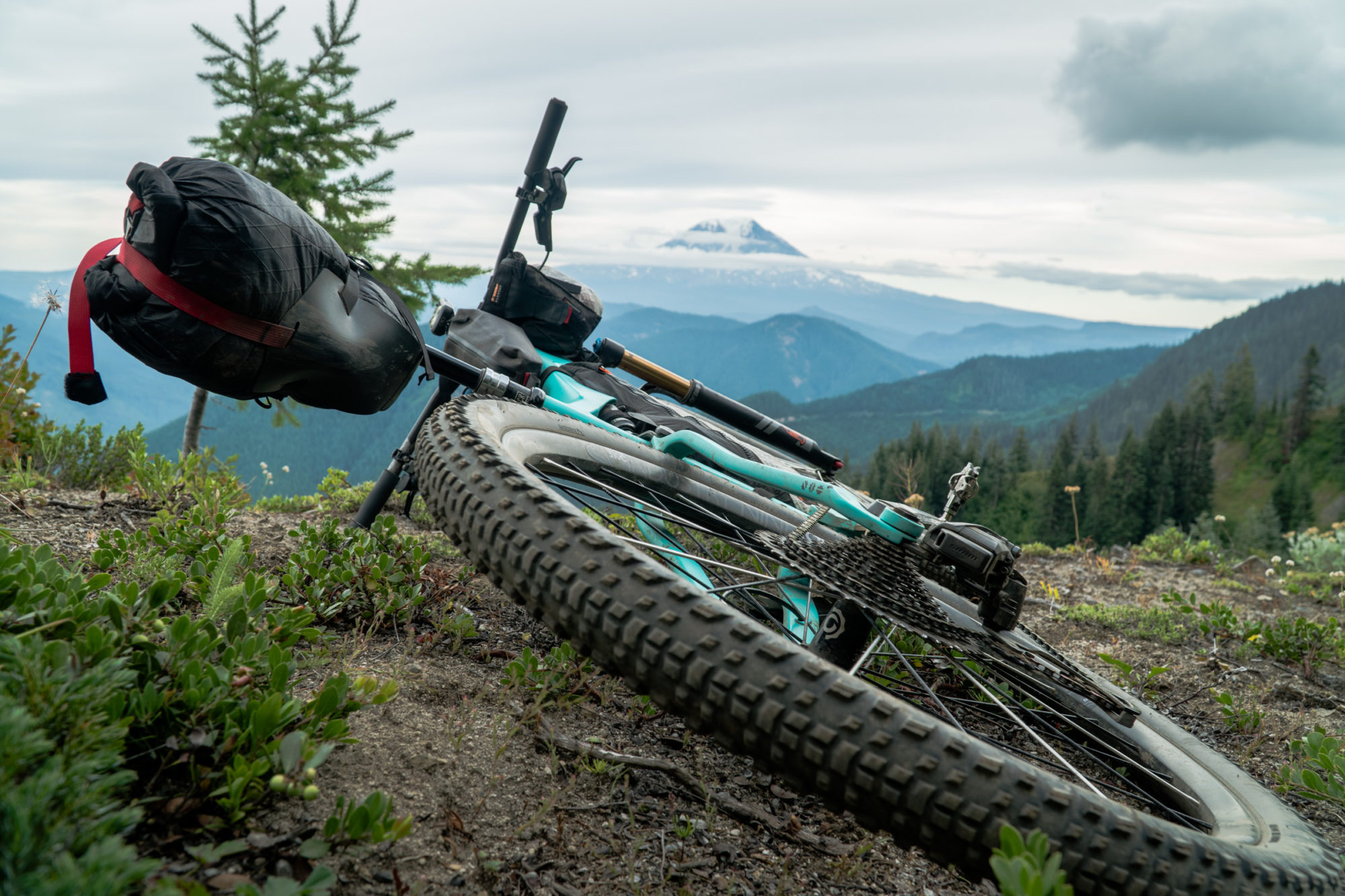
Do you carry spares? How do you charge them while on multi-day trips?
Joe: I carry one spare battery and the small USB charger. I inevitably have a USB cord and backup for my camera, steripen, and GPS, so that’s not additional equipment. Everything gets charged from a cache battery that is kept topped up from a dynamo hub.
Lael: Yeah, for the Tour Divide, I carried two extra batteries. They’re tiny and really easy to swap out as they’re stored in the derailleur. For the Tour Divide, I ran a Sinewave Cycles Beacon dynamo light wired to a SON hub to charge a 20,000mAh cache battery. Generally, I used the battery pack to charge the extra AXS batteries. In addition, I stayed in hotels a couple of times during the Tour Divide and charged everything (AXS batteries, power bank, Wahoo ELEMNT ROAM, iPhone).
Neil: I purchased a bunch of extra batteries just to carry along on trips and rides. I would never charge them on a multi-day trip, I would just replace as needed. They are expensive, but they weigh next to nothing and it’s a simple swap. I also have an “extra” in my AXS dropper post, just in case. I’ve never actually ran out of batteries on my dropper, but they are said to last around 80 hours.
Have you had to change out the CR2032 “watch” batteries in the shifter?
Joe: Nope, haven’t had to yet.
Lael: No. I carried an extra watch battery during the Tour Divide, but it never died. It’s still running fine.
Neil: Nope, have yet to change that battery out. I’ll report back when it dies on me. :)
Have you had any issues with the AXS system on a trip or while out in the backcountry?
Joe: None. I’ve ridden through muddy, rainy, high-altitude rough conditions and the AXS drivetrain is these days the one thing I don’t really think or worry about.
Lael: Near the Montana/Idaho border, the shifters unpaired from the derailleur. They were actually really easy to pair again. I am generally not very good with technology, but this system seems very intuitive.
Neil: No real issues. The one I did have was driving from Colorado to Minnesota. I had the bike on the back rack of my car. When I got home the battery was dead. This was because of all the rattling, where the derailleur thought it was working. I now take the batteries out of my bike during long travel.
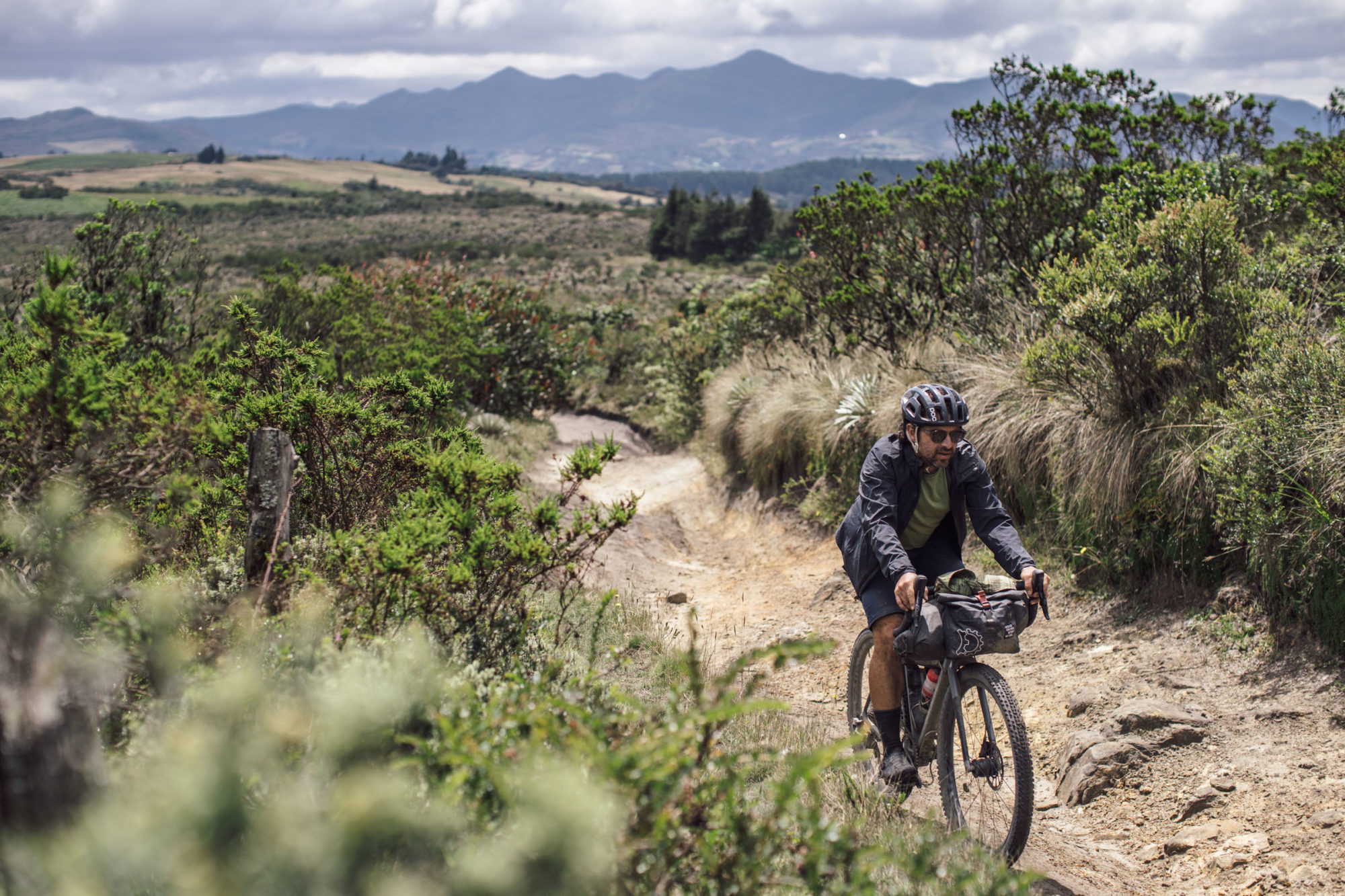
Do you think wireless shifting is ready for long-distance bikepacking?
Joe: Absolutely. With an extra battery—which is tiny and weighs nothing—and a means to recharge, I don’t see any downside. Other than the fact that it’s not cheap, of course. We’re talking about my gravel/dirt touring bicycle here. On my proper expedition fat bike I have mechanical shifting and cable disc brakes. I stand by that build and I’m not necessarily in a hurry to set it up wireless, but if I had the chance to put AXS on it, I would.
Lael: Absolutely—electronic shifting has been such a huge help for me with ultra-endurance racing. In 2015, I raced the Tour Divide twice in a single summer with mechanical trigger shifting. After my second ride, my right thumbnail turned purple and fell off from so much shifting. Electronic shifting is much easier on the hands and wrists and is so precise.
Neil: From a simplicity standpoint, I don’t think anything is as simple as a cable, but if you’re into carrying a charger or extra batteries, it’s worth the crisp, reliable shifting. I’m of the mindset that tech can break, but it can also be pretty neat to see how much you shift and geek out on the app. Would I use it for an ultra endurance race like the Tour Divide? Potentially, perhaps once they get longer run times on their batteries. That being said, I am using a different electronic system for this year’s Tour Divide, so ask me again in July.
Has wireless/electronic shifting made a meaningful difference to your riding?
Joe: My wife has Shimano Di2 equipped bikes and I’ve worked on them for years, so I’m pretty familiar with electric shifting technology. But AXS is the first electric drivetrain I’ve ever had on one of my personal bikes. It was the typical snarky badge of honor for me: no thanks, good old fashioned cables work just fine, I can rebuild a mechanical derailleur in the dark, biking is about simplicity, friction thumb shifters are ultimate reliable tech. I enjoy being retrogrouchy, but I can also admit that it’s mostly just bravado. With AXS I get perfect shifts every time, even under load, set it and forget it performance, and the nice bonus of customizing functionality (I shift up with the right paddle and down with the left, which just makes more sense to me). The paddle interface is quick and low effort. The fact that it’s wireless makes installation a snap since there are no cables to route, especially not internally, and packing the bike is incredibly easy when you’re able to unbolt the derailleur and put it into a padded pouch in the box. Not to mention that there are no ugly wires. Ask Cass Gilbert, looking sophisticated and stylish is at least 60% of bikepacking. I’m fine riding my mechanical derailleur bikes, but I miss the AXS one when I’m not on it.
Lael: Yes. I rode the Tour Divide in 2015 with a flat bar. AXS shifting made it possible for me to set up my Specialized Epic Hardtail with dropbars and an Eagle cassette—my ideal set up. I love this bike and find it perfectly suitable for the Tour Divide.
Neil: I think so. Over the long haul, it’s just easier to press a button rather than push a mechanical system to shift a bike. It’s also much more easy to adjust on the fly, especially the AXS system. I found myself tinkering it to perfection on day rides. It’s easier than adjusting a barrel, and there’s no cable stretch with electronic shifting. Is electronic shifting perfect, no, but it’s still relatively new. I’ve grown up around tech, which has given me a vested interest in stuff like electronic shifting. As more models become available, I hope prices drop a bit. Only time will tell.
Wrap Up
If you didn’t already see that AXS had a spot within our 2019 Gear of the Year Awards, or I didn’t clearly convey positive vibes above, know that I am quite impressed with the SRAM AXS drivetrain, both in regards to all the technological wizardry behind it, and in use. And while this review is a little different than most, I’d be remiss to not talk about how this system performs out on the trail. In short, it’s exact, crisp, and fast—as you should expect from a really expensive set of components. But it’s also stayed perfectly in tune throughout the several hundred miles I’ve been riding with it.
To be fully transparent, I suppose the ultimate question is whether I’d buy it if I wasn’t testing a media sample, right? No, I couldn’t buy the entire system as I have it. It would be a little bit above my pay grade. However, the MTB shifter and derailleur is a little more feasible as the shifter is about $500 cheaper than a pair of Force AXS levers. Combine that with a GX cassette and chain and you essentially have a realistic, high-end drivetrain that’s comparable in price to a full mechanical X01 system. The derailleur and shifter are legitimately worth the investment.
All that said, if you have the budget and have been on the fence, I wouldn’t hesitate to recommend it. It truly is a brilliant piece of technology that works incredibly well, and based on my experience (and what you read from the others above), seems overwhelmingly reliable to boot. However, more exciting to me is the fact that AXS is what I would consider a very successful proof of concept. Based on the pricing that SRAM assigned it at launch, I don’t think they were expecting to sell millions of the group. But the fact that it’s specced on the highest-end bike model of many brands shows that they are very serious about moving the concept forward. With that, I expect to see a lot more development put into it and can already envision a slightly more affordable “AXS GX” group that will put the magic in even more riders’ hands.
Please keep the conversation civil, constructive, and inclusive, or your comment will be removed.






